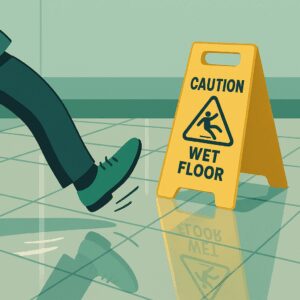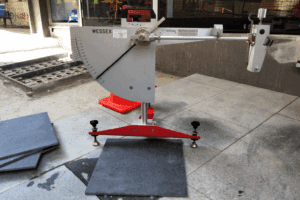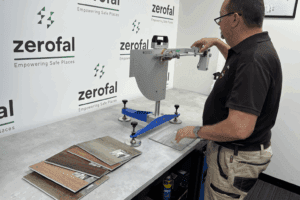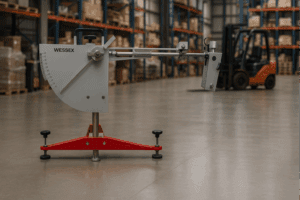“It Looked Fine” : When Visual Safety Isn’t Enough
“Why visual checks aren’t enough”
Many workplaces rely on visual checks to assess floor safety—but looks can be dangerously misleading. This article explains why compliance demands objective slip testing, not just clean tiles and polished finishes.
A shiny new floor doesn’t mean a safe one. And clean doesn’t mean compliant.
We see it too often: newly installed tiles in an office lobby or shopping centre look pristine—until someone slips. The risk isn’t always visible, and relying on appearance alone to judge surface safety can lead to costly, dangerous mistakes.
The Illusion of Visual Safety
Many pedestrian surfaces look safe. Polished porcelain in a foyer. Vinyl plank in a hallway. Sealed concrete on a balcony. When dry, they feel fine underfoot. But add a little moisture—from rain, mopping, or even condensation—and the risk of slipping rises sharply.
Slip resistance isn’t about what you see. It’s about what you test. Microtexture, rubber contact, surface wear—none of these are visible to the eye.
That’s why “it looked fine” is never an excuse after an injury.
What Standards Demand
Australian Standards set strict thresholds for pedestrian surface safety:
- AS 4586-2013 applies to new surfaces, tested in a lab or onsite before installation.
- AS 4663-2013 applies to existing surfaces, tested in the field for real-world performance.
- HB 198-2014 is the guide of what the slip resistance needs to be appropriate in common applications & verify compliance.
Each specifies acceptable slip resistance levels (e.g. P3 or P4 under the wet pendulum test) depending on where and how the surface is used. Retail entries, lobbies, commercial kitchens, hotel bathrooms—each has different requirements. And none of them are met by appearance alone.
Real Data Tells the Story
 Lab-tested materials show the gap between what looks safe and what is. For instance:
Lab-tested materials show the gap between what looks safe and what is. For instance:
- A timber-look vinyl plank that achieved P3 under wet conditions may still be risky in high-traffic areas
- A clear anti-slip coating that barely changed appearance tested at P5, the highest possible rating AS-4586-2013
- Uncoated or worn surfaces often drop to P1 or P2, despite appearing clean.
The only way to know is to test.
Why It Matters
Slip injuries are one of the leading causes of workplace and public liability claims in Australia. The consequences go beyond a bruised hip:
- Injury and compensation claims
- Compliance breaches under WHS and NCC
- Increased insurance premiums
- Reputational risk in public-facing facilities
All avoidable with routine, standards-based testing.
What To Do
Visual checks are not enough.
Ensure:
- Pre-installation testing of all new materials to AS 4586-2013
- Routine in-situ testing of existing surfaces under AS 4663-2013
- Independent, NATA-accredited testing—never rely on contractors with a conflict of interest.
Zerofal conducts both lab and field tests using the same equipment referenced in the standards: the Wessex Portable Skid Resistance Tester (wet) and the Tortus 3 (dry). Results are certifiable, auditable, and ready for compliance records.
Stop Guessing. Start Testing.
If you’re installing or maintaining pedestrian surfaces, get them tested. If you’ve had a near miss—or worse, an incident—it’s time to verify.
Contact Zerofal for accredited slip resistance testing and expert advice on surface safety.
Ready to stop guessing and start testing?
Our lab-based slip resistance testing gives you fast, certifiable results—so you can meet your compliance obligations with confidence.
Slip Testing, Visual Risk, Compliance, Floor Safety, AS 4586
Stay Ahead of Safety Standards
Join the Zerofal newsletter for actionable insights on slip testing, compliance updates, and smart prevention strategies. No spam – just practical safety advice.
Explore more

Colour, Grit and Surface Finish: How Subtle Differences Change Slip Ratings (AS 4586:2013)
Colour, grit and finish change slip resistance. Learn why P-ratings vary across tile ranges and coatings

Why One Slip Test Isn’t Enough for Product Lines (AS 4586:2013)
Slip resistance varies across colours and finishes. Learn why one AS 4586 test cannot certify an entire product line.

Industrial Slip Resistance: Dust, Boots & Coating Drift (AS 4663:2013)
: Industrial floors change fast. Learn how dust, coatings and machinery reduce slip resistance and why AS 4663 onsite testing is essential.
